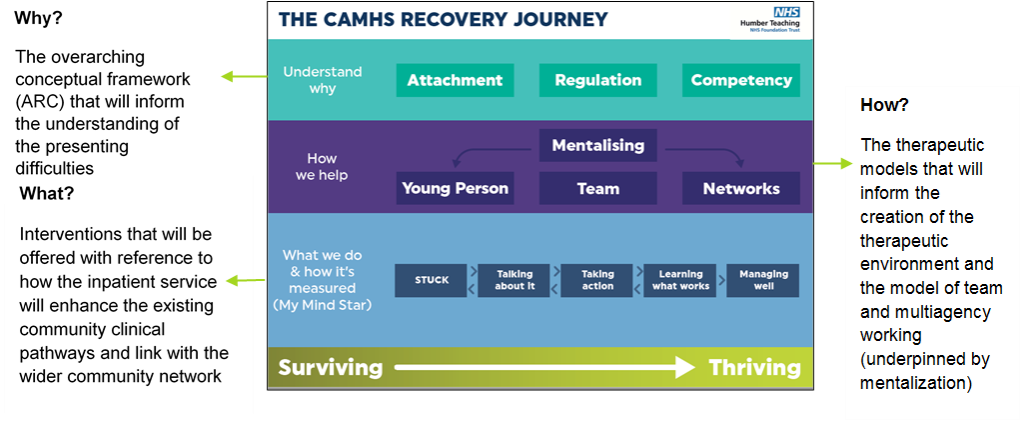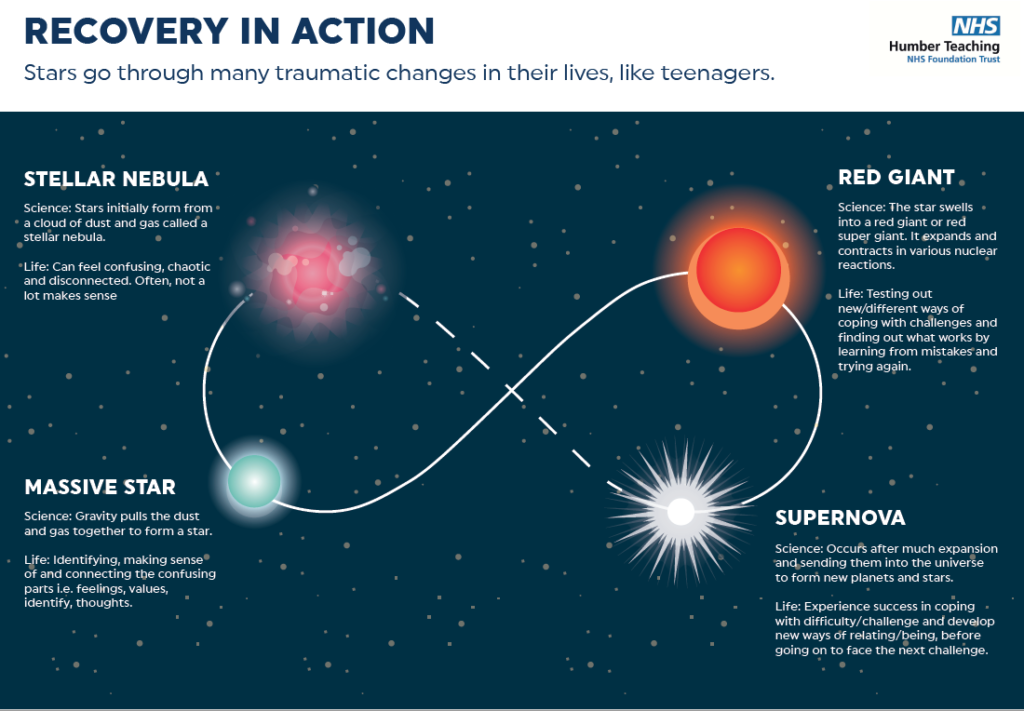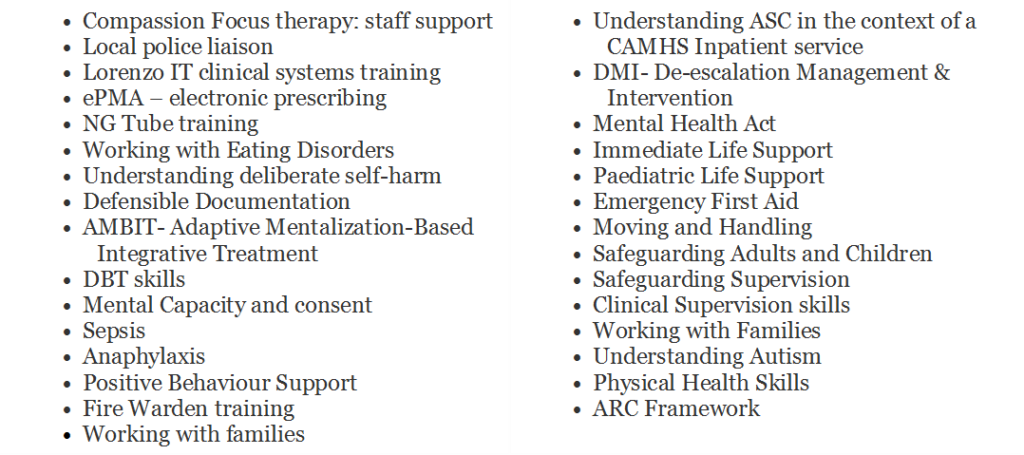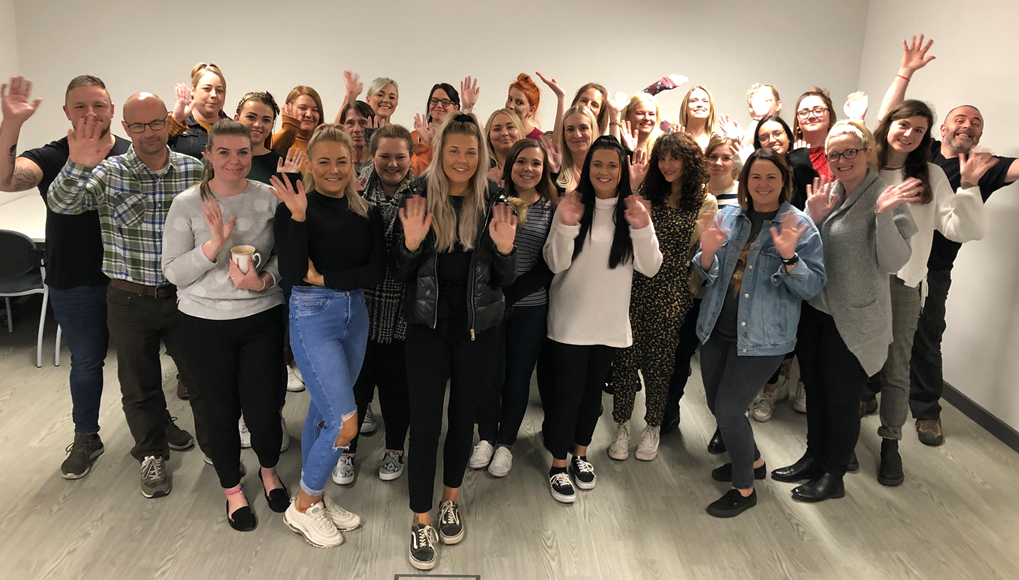The National i-THRIVE Programme spoke with Paul Warwick, Clinical Lead for Inspire CAMHS Inpatient Service, and Peter Flanagan, General Manager, at Humber Teaching NHS Foundation Trust about the co-designed clinical model for the Inspire CAMHS Inpatient Service, and their innovative staff recruitment process led by young people.
Download this implementation story.
Background
Humber Teaching NHS Foundation Trust have been commissioned by NHS England to provide a new 13 bedded CAMHS inpatient unit, including 9 general adolescent beds and a 4 bedded psychiatric intensive care unit (PICU) for the young people of Hull, East Riding of Yorkshire, North Lincolnshire and North East Lincolnshire. The service opens in November 2019.
The Inspire CAMHS Inpatient Service will be fully integrated with, and supported by, the local CAMHS teams and partner agencies and aspires to provide a whole service, community and multiagency approach aligned with the principles of the THRIVE Framework for system change (Wolpert et al., 2019). By working in partnership with current community resources, the service will advocate the idea of ‘step in and step out’ rather than ‘step up and step down’.
Clinical Model: Surviving to Thriving
From the outset the service has been co-designed with young people (see their implementation story here). Collaboration with young people has continued to be a priority. It was important to develop a common language for practitioners and young people that fits with how we the wider CAMHS system understands mental health needs in young people, and is a key principle of the THRIVE Framework. The Attachment Self-Regulatory Competency (ARC) Approach (Kinniburgh and Blaustein, 2005) was identified as a framework to guide intervention, whilst acknowledging the developmental and social context. A CAMHS recovery journey visual was created outlining the different elements of the inpatient service model.

Expanding on the collaborative working to design the inpatient building, the team worked with young people to create the Recovery in Action image based on the life cycle of a star. The purpose of this was to help young people to understand the recovery journey, this is an ongoing process of recovery with an inpatient admission being part of that journey.

Recruitment and training of staff
Following the early engagement with young people a clear message in the development of the service was to ensure that the service would be well staffed, with well trained staff who understand the needs of the young people. We took an innovative approach and decided it would be important to include young people in all aspects of the recruitment process and as a result:
- All staff members have been recruited through an interview process that included activities led by our young people. This has taken the form of group activities and/or applicants being interviewed by a panel of young people/parents.
- All posts have been recruited following a similar process that either included an activity and/or an interview panel led by young people and supported by Trust staff.
- All staff are receiving a bespoke training package to ensure the delivery of the clinical model before the inpatient service opens in November.
Young person led activity
This took the form of:
- A group activity led by young people that consisted of a group circle where young people sat with the applicants and reflected upon an event or situation agreed in advance. Applicants were expected to share a level of personal experience.
And/or
- The applicants joining the young people in leisure activities such as craft or problem solving. This would demonstrate to the young people the applicant’s ability to communicate in a series of therapeutic activities such as would be used on the unit.
Young Persons Panel
Each applicant presented to the young people for 3 minute on a pre agreed topic; an example being: “Tell me something about yourself that would be of interest to me”. The young people then asked pre agreed questions and scored the applicants response. Following both activities the young people scored each applicant based on:
- Body language
- Eye contact
- Communication skills
- Being young people friendly
Professionals Panel
The final part of the interview was a formal Trust interview that included the scores from the young people’s activity and panel. Depending on the post and the number of applicants this process varied. For example, for the Lead Family Therapy post the professional panel were joined by a parent with lived experience.
Recruitment case example:
For the Healthcare Assistant (Band 3) posts we received over 200 applications. Prior to shortlisting we received a number of enquiries from applicants with a variety of lived experience which may not translate in an application form. We decided to offer all applicants an interview and invited 202 candidates to meet Senior CAMHs managers and Clinicians in a “speed date” type of interview. Over an exhausting evening the 15 CAMHS professionals interviewed 147 applicants, shortlisting 43 to hand over to our panel of young people.
We were supported by St Mary’s Sixth Form College, Hull, who brought 15 young people to support the second stage of the interview. The young people decided to run a group activity where they sat the applicants in small groups and facilitated a group discussion on topics such as social media and young people’s mental health.
Following this, the young people interviewed all the candidates using the panel process as described above. Working as a group, the young people agreed on the best 22 candidates that they thought would complement the team with the right skills.
Staff feedback on their experience of being interviewed by young people:
- “Being interviewed by young people made us think deeper in to our answers, to ensure we could be young person friendly. However, upon reflection, the young person interviews helped us believe we were more capable of working with adolescents than we once thought.”
- “More nerve wracking, didn’t know what to expect, harder to prepare for, felt more important, glad that they had that important role, glad that they were involved, greater sense of achievement, harder to impress.”
Young people’s feedback on their experience of being involved in the staff recruitment process:
- “It was interesting and I liked that I got to see what it would be like in an interview. It was fun and exciting to be part of”. HG
- “It was a beneficial experience and challenging in a good way. It felt like I was being included in the development of the new service and that my voice would be heard”. EG
- “Participating in the young people’s interview panel was a great experience. It allowed me to feel I was included in a service I am passionate about, as well as providing me with skills I can now take forward with me. It was an essential part of building the new service and gave a sense of inclusion for young people. It made me believe that CAMHS valued my opinion”. JH
- “To think that I had the power to decide who worked in the new service was exciting and scary, I enjoyed asking the Pharmacist “if you were a drug what drug would you be and why?” their answers were funny and very interesting”. HW
Training package
External training in The Attachment Self-Regulatory Competency (ARC) Approach (Kinniburgh and Blaustein, 2005) has been delivered to the whole staff team over two days. ARC provides a framework to guide and inform treatment choices while recognising the need for individually tailored intervention (as described above). The staff team have received additional training in Adaptive Mentalization Based Integrative Therapy (AMBIT) and Compassion Focussed Staff Support (CFSS) which fit with a neurobiological understanding of distress as per the ARC framework. AMBIT is a whole-team approach designed for services who work with clients presenting with multiple and complex problems, including mental health difficulties. It is based around the core theory and practices of Mentalization and supports teams to apply mentalisation in face-to-face work with clients, between team members, and across networks.
Externally facilitated Compassion Focussed Staff support training has provided staff with a model that encourages them to build their own regulatory system in order to support the young people in their care to actively explore, process and integrate historical experiences.
The comprehensive training package covered:

Feedback from staff successfully appointed to the Inspire CAMHS Inpatient Service Team
How do you think having young people supporting the recruitment process contributed to getting the right staff team in place?
The questions the young people asked struck a perfect balance between personal and professional. The young people were the most important people throughout the whole process, and were the best people to detect who would work best within this team. It also helped knowing that the young people found the staff approachable.
What is the advantage of recruited staff having time together to train prior to the unit opening?
As well as having such a bespoke training package which will continually support us to work to the best of our abilities, we all feel that this time has provided us with time to build relationships. We are all new staff at a new service, using everyone’s individual skills to formulate a diverse and fabulous staff team. This has also supported team building, getting to know each other and having time to build a culture.
What are your thoughts about being able to contribute and shape the development of a brand new inpatient service?
It has been a privilege to develop and shape a new inpatient service. We feel as if we are making a difference, and shaping an effective, purposeful service to better CAMHS care, which will help shape the future of services. We wanted to bring to the service a different culture, new perspectives, and create a culture of respect.
Thoughts about the service from other members of the team:
- “Innovative, ground breaking, inspiring” – Liam Smith, Assistant Psychologist.
- “We can be a driver for change” – Emily Drake, Registered Nurse.
- “Exciting – we can all start as we mean to go on” – Joanna Beal, Social Worker.
Humber Inspire CAMHS Inpatient Service Team
In summary
In our first implementation story (accessible here) we profiled what local young people told us they wanted to see in the new unit, including design features, the interpersonal qualities of staff and how the overall offer needed to be different from what is currently provided. In this implementation story we have focused on how we made those aspirations a reality. This has included a clear articulation of how we plan to work with young people in meeting their needs, as well as drawing the parallels with the life cycle of a star in terms of that being a journey of growth and development. We have also included the detailed approach to recruitment and the role young people have played in that in identifying those individuals with the right values and core skill set to be part of a great team. Our final implementation story in this series will offer an early insight, into how the “whole” project is making a difference to local young people.
If you would like further information, please contact Paul Warwick at pwarwick1@nhs.net or Peter Flanagan at peterflanagan@nhs.net.
Edited by the National i-THRIVE Programme Team.
Written October 2019.
←Back to i-THRIVE Implementation Stories